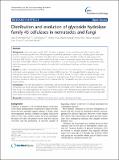Files in this item
Distribution and evolution of glycoside hydrolase family 45 cellulases in nematodes and fungi
Item metadata
| dc.contributor.author | Palomares-Rius, Juan E. | |
| dc.contributor.author | Hirooka, Yuuri | |
| dc.contributor.author | Tsai, Isheng J. | |
| dc.contributor.author | Masuya, Hayato | |
| dc.contributor.author | Hino, Akina | |
| dc.contributor.author | Kanzaki, Natsumi | |
| dc.contributor.author | Jones, John T. | |
| dc.contributor.author | Kikuchi, Taisei | |
| dc.date.accessioned | 2015-09-17T16:10:03Z | |
| dc.date.available | 2015-09-17T16:10:03Z | |
| dc.date.issued | 2014-04-01 | |
| dc.identifier | 208027538 | |
| dc.identifier | f69a56c5-d257-49cd-b60a-eeafe7ad33b8 | |
| dc.identifier | 000334468700001 | |
| dc.identifier | 84898440739 | |
| dc.identifier.citation | Palomares-Rius , J E , Hirooka , Y , Tsai , I J , Masuya , H , Hino , A , Kanzaki , N , Jones , J T & Kikuchi , T 2014 , ' Distribution and evolution of glycoside hydrolase family 45 cellulases in nematodes and fungi ' , BMC Evolutionary Biology , vol. 14 , 69 . https://doi.org/10.1186/1471-2148-14-69 | en |
| dc.identifier.issn | 1471-2148 | |
| dc.identifier.uri | https://hdl.handle.net/10023/7500 | |
| dc.description | Date of Acceptance: 17/03/2014 | en |
| dc.description.abstract | Background: Horizontal gene transfer (HGT) has been suggested as the mechanism by which various plant parasitic nematode species have obtained genes important in parasitism. In particular, cellulase genes have been acquired by plant parasitic nematodes that allow them to digest plant cell walls. Unlike the typical glycoside hydrolase (GH) family 5 cellulase genes which are found in several nematode species from the order Tylenchida, members of the GH45 cellulase have only been identified in a cluster including the families Parasitaphelenchidae (with the pinewood nematode Bursaphelenchus xylophilus) and Aphelenchoididae, and their origins remain unknown. Results: In order to investigate the distribution and evolution of GH45 cellulase genes in nematodes and fungi we performed a wide ranging screen for novel putative GH45 sequences. This revealed that the sequences are widespread mainly in Ascomycetous fungi and have so far been found in a single major nematode lineage. Close relationships between the sequences from nematodes and fungi were found through our phylogenetic analyses. An intron position is shared by sequences from Bursaphelenchus nematodes and several Ascomycetous fungal species. Conclusions: The close phylogenetic relationships and conserved gene structure between the sequences from nematodes and fungi strongly supports the hypothesis that nematode GH45 cellulase genes were acquired via HGT from fungi. The rapid duplication and turnover of these genes within Bursaphelenchus genomes demonstrate that useful sequences acquired via HGT can become established in the genomes of recipient organisms and may open novel niches for these organisms to exploit. | |
| dc.format.extent | 12 | |
| dc.format.extent | 4073860 | |
| dc.language.iso | eng | |
| dc.relation.ispartof | BMC Evolutionary Biology | en |
| dc.subject | Bursaphelenchus | en |
| dc.subject | Cellulases | en |
| dc.subject | Horizontal gene transfer | en |
| dc.subject | Ascomycota | en |
| dc.subject | Fungi | en |
| dc.subject | QH301 Biology | en |
| dc.subject.lcc | QH301 | en |
| dc.title | Distribution and evolution of glycoside hydrolase family 45 cellulases in nematodes and fungi | en |
| dc.type | Journal article | en |
| dc.contributor.institution | University of St Andrews. School of Biology | en |
| dc.contributor.institution | University of St Andrews. Biomedical Sciences Research Complex | en |
| dc.identifier.doi | 10.1186/1471-2148-14-69 | |
| dc.description.status | Peer reviewed | en |
This item appears in the following Collection(s)
Items in the St Andrews Research Repository are protected by copyright, with all rights reserved, unless otherwise indicated.

